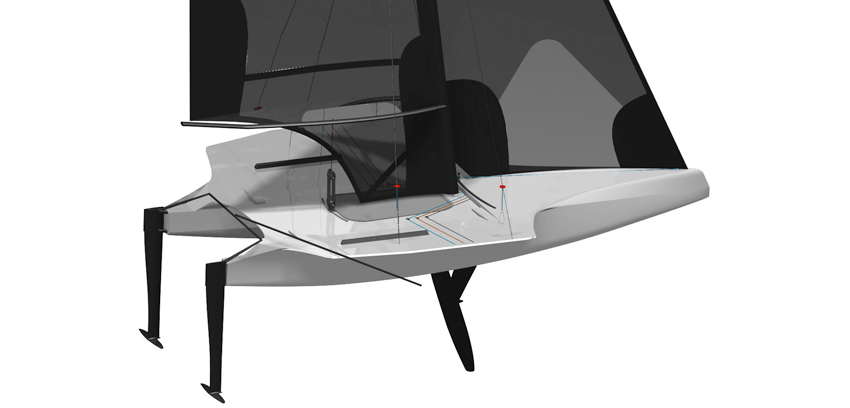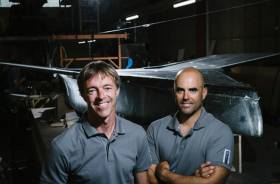Displaying items by tag: NTFM Syra 18
Besides the strong third-place showing by David Kenefick on Lake Garda a week ago, International Foiling Week also saw the launch of a new two-person foiling dinghy.
The NTFM Syra 18 is the brainchild of America’s Cup winners Niels Frei and Yves Detrey, and is being touted as the first double-handed monohull foiling dinghy.
Its design concept hinges on a canting T-foil system, and an innovative hybrid monohull shape to keep the boat stable at low speeds and in no-foiling mode. The aim is to dispel the notion that foiling is technically demeaning and carries higher risk than traditional sailing.
Indeed, its creators say the design’s key principles (see below) will ensure that the NTFM Syra 18 will be accessible to the widest possible range of sailors through its combination of simplicity, versatility and stability with blistering performance potential.

The team behind the NTFM Syra 18 have been sailing all their lives and have impeccable credentials. Nils Frei and Yves Detrey are two-time America’s Cup winners with Alinghi, and have competed consistently at the highest level on the D35 and GC32 circuits.
“I have been addicted to foiling ever since my first flight,” Nils says. “There are two aims with the NTFM Syra 18: to offer the best experience of foiling flight to the widest possible range of sailors regardless upon experience and ambition; and, to produce a boat suitable for Olympic competition.
“We are fortunate to have been supported in our ambitions by our partners Isabelle Rinsoz and Publiaz, both of whom have been real assets.”
Yves adds: “When we first hatched the idea, we knew we had to prove the concept before launching in the marketplace and to make sure our aims were realistic. We wanted buyers to have the best possible experience from the moment of purchase and for the boat to have the potential to enhance sailing at the Olympics.
“We are close to reaching that point and are looking forward to getting the first production boats in the water.”
The initial design drawings for the NTFM Syra have been produced by VMG Yacht Design in Lausanne. And the first boat to be launched will be named SYRA by Publiaz, after NTFM’s main partner.
The boat will be tested and optimised, taking part in some classic races primarily in the western part of Switzerland where Publiaz has its main business focus. Thanks to Publiaz’s engagement, NTFM Syra will be able to prepare the launch of the production models in an optimal manner.
Key Design Principles
Safety
The hybrid hull shape means to boat is stable at low speed and in no-foiling mode, making leaving and returning to shore a safe proposition in light or even gusting conditions. With one central T-foil in the water, there are no sharp, trailing edges above deck-height reducing the risk of physical harm. The double rudder configuration adds stability and their position beneath the hull wings greatly reduces the risk of injury when falling overboard. Finally, the hull shape and foil configuration offer a number of set-ups which will enable the NTFM Syra 18 to be sailed by a broad range of experience, weight and age. While the most experienced will be ready to foil straight off the beach, less-experienced sailors will be able to grow into the boat taking steps that increase speed and excitement as and when they are ready.
Efficiency
The hybrid monohull shape is low-drag and the deck-sweeper mainsail is highly efficient. The main canting T-foil and the double rudder system, which offers the possibility to apply differential, means significant righting-moment with or without use of the optional trapeze. Dynamic adjustment of the main T-foil makes depowering sails in gusts unnecessary. Trimming the foil allows power to be kept on, promoting acceleration on a stable, reassuring platform. Flight height is regulated by a proven mechanical wand system. Changeable foil tips promote optimisation in a range of conditions and the single central foil makes tacking and gybing straight-forward. Mainsheet location is behind the deck sweeper and the curved traveller rail will allow for easy trimming. The set-up is completed by a self-tacking, furling Code 0.
User-friendly
The NTFM Syra 18 is highly versatile, offering safe, efficient sailing in a wide range of wind conditions for a broad spectrum of sailors. Waterproof pockets and deck window to see foil operation enhance the experience. Launch and recovery are facilitated the retractable rudders and main foil. Foldable wings minimise boat park requirements and mean the boat fits on a standard 2.20m-wide road trailer.





























































